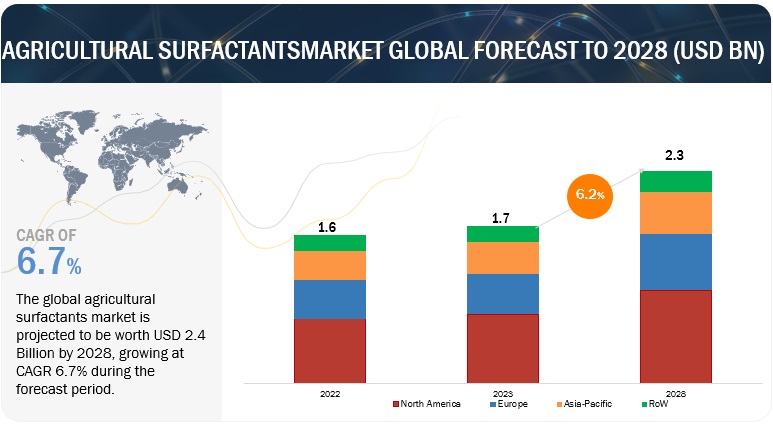
The global agricultural surfactants market is poised for remarkable growth, with an estimated value of USD 1.7 billion in 2023, projected to surge to USD 2.3 billion by 2028, representing a robust compound annual growth rate (CAGR) of 6.2% during this period. This expansion is propelled by a confluence of factors that intertwine pressing environmental concerns and the inexorable rise of the global population.
Environmental Concerns and Population Dynamics
The escalating global population is a paramount factor fueling the growth of the agricultural surfactant market. The United Nations Population Division, in its 2022 projections, foresees the global population reaching 8.5 billion by 2030, 9.7 billion by 2050, and a peak of 11.2 billion in 2100, followed by a gradual decline. This demographic surge underscores the critical need for sustainable agricultural practices to meet the burgeoning demand for food.
Simultaneously, environmental challenges, including climate change and resource limitations, have cast a long shadow over the agricultural sector. To address these issues, there is mounting pressure to enhance agricultural productivity sustainably, making agricultural surfactants a vital tool in the arsenal of modern farming practices.
Agricultural Surfactants: A Boost for Cereals and Grains
Agricultural surfactants are particularly favored in cereals and grains cultivation due to their specialized benefits aligning with the unique characteristics of these crops. Cereals and grains, with their extensive leaf surfaces, require meticulous pesticide coverage for effective pest and disease management. Surfactants play a pivotal role in enhancing the adhesion and distribution of pesticides, ensuring comprehensive coverage across these expansive surfaces.
Moreover, cereals and grains hold significant market value as staple crops, necessitating a keen focus on yield optimization. By maximizing the efficacy of agrochemical applications, surfactants significantly contribute to enhanced yields in this economically significant crop category, firmly establishing themselves as a preferred choice for precision agriculture in cereals and grains.
Dominance of Synthetic Agricultural Surfactants
In the global market, synthetic agricultural surfactants have risen to dominance for several compelling reasons. Their consistent and well-defined chemical compositions assure predictable performance across diverse agricultural scenarios. This reliability is paramount for farmers seeking precise and efficient agrochemical applications, enabling them to meet the growing demand for food production sustainably.
Book a meeting with our experts to discuss your business needs @ https://www.marketsandmarkets.com/speaktoanalystNew.asp?id=52947416
The Asia Pacific Surge
The Asia Pacific region is experiencing rapid growth in the agricultural surfactants market, driven by a synergy of factors. Firstly, this region is home to some of the world’s most populous and agriculturally active countries, necessitating increased crop productivity. As these nations endeavor to feed their burgeoning populations, optimizing pesticide efficiency through surfactant usage becomes imperative.
Furthermore, the adoption of modern agricultural practices and technologies in the Asia Pacific region has heightened awareness of the benefits of surfactants. Farmers are increasingly embracing precision agriculture techniques, making the use of surfactants pivotal in enhancing the effectiveness of agrochemical applications.
The region’s diverse climate and cropping patterns underscore the need for versatile surfactant solutions that can perform effectively under varying conditions. This has led to the uptake of surfactants capable of accommodating a wide range of agrochemical formulations and crop types.
Conclusion
The agricultural surfactants market’s impressive growth trajectory reflects the pivotal role these agents play in addressing the pressing challenges of feeding a growing global population while safeguarding the environment. As the world grapples with the intertwined dynamics of population surge and environmental concerns, agricultural surfactants emerge as a critical tool in the quest for sustainable and efficient food production.